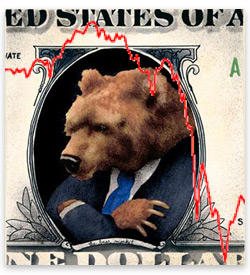 Booms do not merely precede busts. In some important sense, they cause them. This idea, on which so much of the analysis of these pages rests, is borrowed from the Austrian School of economics. It was the Austrians who observed that people in markets periodically miscalculate together. One important source of misjudgment is the interest rates that the central banks impose. A too-low rate provides high spirits and speculation; a too-high rate induces morbidity and contraction. Thus, the ultra-low money-market rates of 1993 not only strengthened balance sheets and reduced mortgage-interest costs, as policymaker intended. They also cause an outpouring of capital investment, as policymakers might or might not have intended. If precedent holds, these projects will be carried to extreme lengths. Like the Manhattan skyscrapers of the 1920s and the Texas oil rigs of the 1980s, the white elephants of the 1990s (coffee bars and semiconductor fabricating plants are the top candidates at this moment) will bring grief to their sponsors and drama to the next recession. Overbuilding and underbuilding constitute opposite sides of the same cyclical coin. James Grant in The Trouble with Prosperity (1997)
Booms do not merely precede busts. In some important sense, they cause them. This idea, on which so much of the analysis of these pages rests, is borrowed from the Austrian School of economics. It was the Austrians who observed that people in markets periodically miscalculate together. One important source of misjudgment is the interest rates that the central banks impose. A too-low rate provides high spirits and speculation; a too-high rate induces morbidity and contraction. Thus, the ultra-low money-market rates of 1993 not only strengthened balance sheets and reduced mortgage-interest costs, as policymaker intended. They also cause an outpouring of capital investment, as policymakers might or might not have intended. If precedent holds, these projects will be carried to extreme lengths. Like the Manhattan skyscrapers of the 1920s and the Texas oil rigs of the 1980s, the white elephants of the 1990s (coffee bars and semiconductor fabricating plants are the top candidates at this moment) will bring grief to their sponsors and drama to the next recession. Overbuilding and underbuilding constitute opposite sides of the same cyclical coin. James Grant in The Trouble with Prosperity (1997)
Ken Shubin Discusses his Advanced Value Investing Course At Columbia’s GBS
http://www.valuewalk.com/2012/02/ken-shubin-stein-on-value-investing-at-columbia-business-school/
Ken mentioned the CIA Manual for Intelligence Analysis (120 pages): https://www.cia.gov/library/center-for-the-study-of-intelligence/csi-publications/books-and-monographs/psychology-of-intelligence-analysis/PsychofIntelNew.pdf
Even Value Investing Professors struggle with understanding how to grasp the critical aspects of a business and its industry. We are trying to avoid such a misunderstanding by our diligent study of competitive advantages.
QUIZ
Ken Shubin is Spence774 here: http://www.valueinvestorsclub.com/value2/Idea/ViewIdea/2998. Here he recommends Winn Dixie Stores(WINN) – $18.61 on Nov 29, 2007
Shubin’s Summary: WINN is less than a 50 cent dollar. It is a post-bankruptcy supermarket chain located in the Southeast in the midst of a multi-year turnaround. WINN’s margins are currently 1/6 of industry average. WINN has temporary, fixable problems with no structural impediments to the achievement of industry average operating metrics. With a strong balance sheet, excellent management, and strategic assets with great potential, we believe WINN shares have the potential to more than double over three years, with little risk of capital loss.
—
The price dropped 50% from his recommended price before the company was bought in December 2011 by another Supermarket chain.
QUESTION: What key question must you ask about Winn-Dixie (Winn)? Where might Winn have any chance of a competitive advantage? How would you analyze this industry? Your studies of Wal-Mart and competitive advantage should give you the understanding to answer this quiz. An answer will be posted in the comments section by tomorrow. What does the “Professor” neglect in his analysis?
Short Idea on Winn: http://www.valueinvestorsclub.com/value2/Idea/ViewIdea/28593
Recommended Blog: http://www.oddballstocks.com/2012/03/adams-golf-gets-buyout-and-other-net.html An investor on the journey of learning how to invest.
The Results of My Aptitude Test
I recently had an extensive aptitude test to prepare me for a career upgrade. Video of my results: http://www.youtube.com/watch?v=gV5OAfKhe34&feature=related

5 responses to “Video on Ken Shubin’s Investing Course at CBS; Winn Dixie Test; Blog Recommendation”